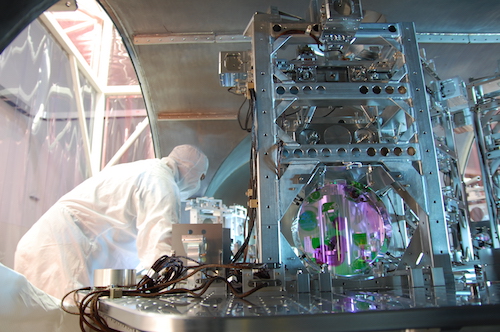
The 2 1/2-mile long L-shaped LIGO interferometer uses laser light split into two beams that travel back and forth down the arms. The beams are used to monitor the distance between mirrors precisely positioned at the ends of the arms. According to Einstein’s theory, the distance between the mirrors will change when a gravitational wave passed by the detector. Image Courtesy of LIGO Laboratory
Latest News
February 24, 2016
Albert Einstein’s 1915 theory of general relativity recently got a giant stamp of approval as an impressive instrument called a Laser Interferometer Gravitational Wave Observatory (LIGO) detector picked up a series of gravitational waves thought to be produced by a collision between two black holes.
 An aerial view of the Laser Interferometer Gravitational-wave Observatory (LIGO) detector in Livingston, Louisiana. Image Courtesy of LIGO Laboratory
An aerial view of the Laser Interferometer Gravitational-wave Observatory (LIGO) detector in Livingston, Louisiana. Image Courtesy of LIGO LaboratoryIn addition to the scientific brain trust and copious resources put forth by the National Science Foundation (NSF), academia and various astronomy consortium, one of the unsung heroes in this groundbreaking discovery is cluster computing. Nor-Tech, a high-performance computing (HPC) services provider, configured and delivered a total of five clusters for the 10-year-old project, including one at Syracuse University boasting 88,000 GPU cores and a trio at the University of Milwaukee totaling 4,000 processor cores.
The discovery of gravitational waves, made on Sept. 14, 2015 by twin LIGO detectors in Livingston, LA, and Hanford, WA, is a milestone in that it’s the first time scientists have observed these so-called ripples in the fabric of space time. Physicists involved in the discovery believe the gravitational waves were produced in the final fraction of a second as two black holes merged to become one — a prediction made by Einstein, but never officially observed.
Using software comprised of over a half million lines of proprietary code, the research team ran signal analysis simulations on the clusters, which detected the waves and validated that they were likely a result of the black hole collision. Based on the observed signals, the LIGO scientists estimated that the black holes were about 29 and 36 times the mass of the sun, and that the event took place 1.3 billion years ago.
 The 2.5-mile long L-shaped LIGO interferometer uses laser light split into two beams that travel back and forth down the arms. The beams are used to monitor the distance between mirrors precisely positioned at the ends of the arms. According to Einstein’s theory, the distance between the mirrors will change when a gravitational wave passed by the detector. Image Courtesy of LIGO Laboratory
The 2.5-mile long L-shaped LIGO interferometer uses laser light split into two beams that travel back and forth down the arms. The beams are used to monitor the distance between mirrors precisely positioned at the ends of the arms. According to Einstein’s theory, the distance between the mirrors will change when a gravitational wave passed by the detector. Image Courtesy of LIGO LaboratoryThe LIGO discovery is the first observation of gravitational waves, thus is an important finding providing insight into the cosmos, says David Bollig, owner of Nor-Tech, which configured the clusters and served as a key integration partner throughout the project. “This opens a new window into the universe,” he says. “It’s hard to say where they’ll go with this knowledge, but it sheds light on the foundation of the universe and helps us slowly piece together the puzzle of life.”
The clusters’ key role was to provide a platform on which to run the complex signal analysis software. “You need to have a lot of horsepower to run these things,” Bollig adds.
The LIGO observatories are funded by the NSF, and were conceived, built and operated by the California Institute of Technology (Caltech) and the Massachusetts Institute of Technology (MIT).
Here’s a clip of a simulation depicting the merger of two black holes:
Subscribe to our FREE magazine, FREE email newsletters or both!
Latest News
About the Author
Beth Stackpole is a contributing editor to Digital Engineering. Send e-mail about this article to [email protected].
Follow DE





